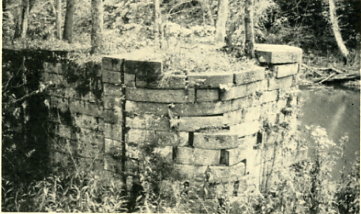
Gretchen's Lock No. 41 on the Sandy and Beaver Canal.
Click Here to Return to Milestones
Although many persons are more or less familiar with the history of the old canal that followed the Beaver River from Rochester to New Castle, very few Beaver Countians are even aware that about the same time there was a canal through the Little Beaver from Glasgow in Beaver County to Bolivar, Ohio. This canal was never so important, nor did it accommodate so many communities and interests as the watercourse whose route traversed this north central section of the county. Nevertheless, it deserves proper mention for the part if played in furthering the cause of internal commerce.

The plans for such a canal were first talked of by legislators from Ohio in which State the greater length of the Little Beaver flows. On January 11, 1826, it was incorporated by the Ohio General Assembly. It was not until two years later, April 14, 1828, that Pennsylvania lawmakers regarded the matter kindly enough to charter the project.
In the next several years, engineers surveyed the length of the narrow river from its source in Eastern Ohio to Glasgow, where the stream joins the wide expanse of the Ohio. Work was officially started in 1835, the employees of the contractors to whom the project had been awarded began their activities in New Lisbon, Ohio.
Camps in which the laborers lived sprang up at intervals along the entire course of the stream. The laying out of the village of Glasgow was in fact prompted by the hopes of the future importance to be given this section of the state by the construction of the Sandy and Beaver Canal.
Two years after the work had been started it was given its first drawback. The financial crisis of 1837 occurred and legislatures of both states found themselves faced with the problem of stretching all money in their possession doubly far and staving off needed public improvements and demands until such time as the near panic might pass and business return to normalcy. As a result, it was many a long month after the first ground was broken until the celebration of its completion was held in 1846. Visitors came from far and wide, north and south and all marvelling at the beauty of the area and its views of mountain landscapes.
Building of the canal was attended by a tragedy to its chief engineer that brought sorrow to all the people residing in the vicinity of the watercourse. E. H. Gill was the engineer's name. Although only in the prime of life, this man had won wide renown for his skill. He had been urged to come from his headquarters in Paris, France to superintend the work here. On the way to America, Mrs. Gill was washed from the deck of the frail ship on which they were making the crossing when a huge wave crashed high over the vessel, and retreated, carrying with it a half dozen travelers. Those who were thus thrown from the ship were never again seen by mortal eye.
The death of his wife was a severe blow to Gill, but he could not alter his plans at that late date. So with his little seven yearold daughter, his only child, he continued to Beaver County. At Glasgow, which was one of the first places he was stationed, townspeople soon grew to love the motherless girl whose winsome ways and sad little smile endeared her to their hearts. Sometimes when Gill's work took him miles up the Little Beaver into Ohio country, he would leave the child with friends in Glasgow. More often, however, the little girl pleaded that she accompany him and not having the heart to refuse, the engineer took her along. And so she made her home with him in the rough and tumble labor camps along the stream. She became the mascot, one might say, of those grizzled fellows who labored day and night that the canal might be thrown open to traffic.
It was at one of those outdoor camps that she was stricken suddenly ill. A physician was summoned and the worried father was told that his little one had a bad case of fever. The doctor held slight hope for her recovery. Her illness threw sadness over the entire camp, and farm wives residing in the locality hovered close with words of advice and offers to cook something which the child could eat. Small as she was, the girl sensed somehow the seriousness of her illness. While her father listened to her feeble words, his eyes filled with tears, the tot asked that she be buried beside her mother. Her wish was to be granted in a manner which wrote the final chapters to the tragedy of Gill's wife.
When the little child died, the engineer, unable to leave his duties, made arrangements for the casket to be kept in a stone tomb in an Ohio community until his return abroad. When the dam was finished and legislators of both Ohio and Pennsylvania had given it their official approval, he reclaimed the child's remains and returned to Baltimore, boarding a boat bound for France. Several weeks later, local people learned that the boat had foundered during a severe storm off the Madeira Islands. All aboard were lost. The child's wish had been fulfilled. King Neptune had reunited the Gills.